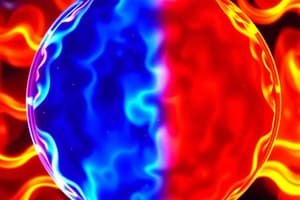Podcast
Questions and Answers
Explain the terms system and surroundings in the context of thermodynamics.
Explain the terms system and surroundings in the context of thermodynamics.
The system refers to the part of the universe under study, while the surroundings include everything outside the system.
What is Hess’s law of constant heat summation?
What is Hess’s law of constant heat summation?
Hess’s law states that the total enthalpy change for a reaction is the same, regardless of whether the reaction takes place in one step or in a series of steps.
What is the first law of thermodynamics and how is it expressed mathematically?
What is the first law of thermodynamics and how is it expressed mathematically?
The first law of thermodynamics states that energy cannot be created or destroyed, only transformed. Mathematically, it can be expressed as ΔU = q + w, where ΔU is the change in internal energy, q is the heat added to the system, and w is the work done on the system.
Differentiate between spontaneous and nonspontaneous processes in thermodynamics.
Differentiate between spontaneous and nonspontaneous processes in thermodynamics.
Explain the relationship between Gibbs energy change (∆G) and spontaneity, as well as ∆G and equilibrium constant.
Explain the relationship between Gibbs energy change (∆G) and spontaneity, as well as ∆G and equilibrium constant.
Flashcards are hidden until you start studying
Study Notes
Thermodynamics Unit Summary
- Thermodynamics is a physical theory of universal content that is believed to never be overthrown within the applicability of its basic concepts.
- After studying this unit, one will be able to explain the terms: system and surroundings.
- Differentiation between close, open, and isolated systems is covered in the unit.
- The unit covers the explanation of internal energy, work, and heat, as well as the first law of thermodynamics and its mathematical expression.
- Students will learn to calculate energy changes as work and heat contributions in chemical systems.
- The unit covers the calculation of enthalpy changes for various types of reactions.
- Hess’s law of constant heat summation is explained and applied.
- Extensive and intensive properties are differentiated and defined.
- The concept of spontaneous and nonspontaneous processes is covered in the unit.
- Entropy as a thermodynamic state function is explained and applied for spontaneity.
- The concept of Gibbs energy change (∆G) is explained.
- The unit establishes the relationship between ∆G and spontaneity, as well as ∆G and equilibrium constant.
Studying That Suits You
Use AI to generate personalized quizzes and flashcards to suit your learning preferences.




